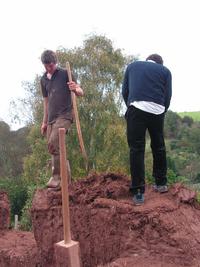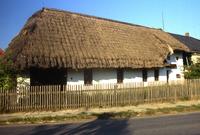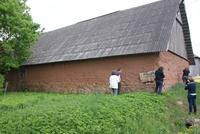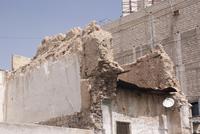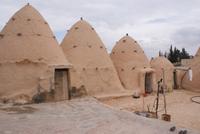What is cob?
Cob is a walling material that is formed with subsoil without being modified by subjecting it to heat such as baking that forms clay bricks or by adding cementitious material to it. It is essential that the cob contains clay as this acts as the binder to the soil particles and gives it its strength. If too much clay is present in the subsoil, it will lead to excessive shrinkage and cracking of the wall as it dries. The clay content of cob can vary depending upon the subsoil used but is usually in the range of 10% to 20%. Fibrous material is usually added to the mix. The wall is formed by placing the wet cob mix on top of the construction previously laid and compacting it by treading and beating the material. Without the fibrous material, which is usually straw, the cob would slump off the top of the wall while it was being compacted and is added primarily to aid the placing of the wet subsoil on the wall. The fibrous material may provide some tensile strengths in the finished wall construction but this has yet to be fully proven. It is often said that dung is included in the mix. This is most likely to have occurred due to the mixing process which may have been carried out using cattle, contained within a pen with the subsoil and straw, so that after a period of time the material becomes mixed by the treading of the animals' hooves.
Cob is just one form of earth building construction used throughout the world. The other main methods are to form blocks or bricks of unbaked earth which are pre-dried. This is particularly useful where the clay content of the soil is high. Pre-drying the blocks eliminates most of the shrinkage. This is commonly known as Adobe. Pre-formed cob blocks are produced and sold in the South West of England and are often used for the repair of existing buildings where larger areas of wall are to be replaced.
The other main method is to place the subsoil between shutters or formwork. This allows subsoil with a lower moisture content to be placed which reduces the amount of shrinkage while also allowing greater compaction of the material as it is contained within the shutters. This method is commonly known as Pisé and was adopted as a method of construction throughout Britain in the twentieth century for low cost housing particularly during the 1920s and '30s following publication of books by Clough Williams-Ellis.
Cob is the predominant earth walling technique found in the South West of England. It is also found in other areas of the British Isles: South West Wales where it is known as Clom; North West Cumbria where it is known as Clay Dabbins; in small areas such as around Haddenham in Berkshire where it is known as Wichert; and in an area south of Stratford-upon-Avon in Warwickshire and across into the area between Leicester and Northampton. An Adobe-type construction is also found in Norfolk where it is known as Clay Lump. In the chalk areas of Dorset, Wiltshire and Hampshire, buildings formed with rammed chalk and chalk cob can be found.
For most areas of the world, earth construction is seen as low status and of little value, used only by the very poor. It is often seen as old and outdated and the local population have a desire to vacate such buildings in favour of new brick or concrete houses. The South West of England is therefore probably unique in having a high concentration of earth buildings which are not only seen as desirable but are also extremely valuable. As a censequence, the proper maintenance of these buildings is financially viable and expected. This is the main driving force behind the development of our knowledge and expertise in dealing with earth buildings and providing a service for the owners. It also means that there is a vibrant and well established network of builders who are experienced in the repair and maintenance of cob as can be seen in the list of Cob Builders.
Other websites of interest concerning earth buildings:
Terres à Terres
Cob being "trodden" onto a wall.
Earth buildings are found throughout the world -
In Czech Republic
In Estonia
In Damascus
Rural Syria

